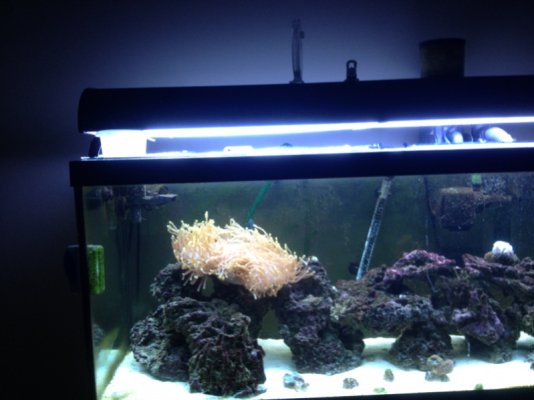Rmckoy
Aquarium Advice FINatic
- Joined
- Mar 23, 2013
- Messages
- 919
I'm not exactly sure what kind of anemone that is of the top of my head though if it hasn't moved in months, and it is routinely that relaxed it is a pretty good sign that it is fairly happy. It is a little odd that it has perched so high in the tank. There is only one carpet anemone that I know of that routinely does that. This could be a sign that your lights are underpowered.
I have t5 HO
6 bulbs .
3 white and 3 blue .
And moon lights are 2 of the 6 blue lights .
They might be due for changing but they work so figured to use them .
It's huge !!
Right now as I speak its about 12-16 inches across
I feed it twice a week .
A combination or 2 small scallops and 1 shrimp cut into 1/2" pieces
With T5s, you need to change your bulbs out at least every 12 months. Although they quite likely will still light, they dim over time and will also have a color shift as well. Also, anemones will sometimes blow themselves up with water in order to maximize their surface area and therefore the amount of light they're collecting, so size does not always equate with growth or health necessarily.
With T5s, you need to change your bulbs out at least every 12 months. Although they quite likely will still light, they dim over time and will also have a color shift as well. Also, anemones will sometimes blow themselves up with water in order to maximize their surface area and therefore the amount of light they're collecting, so size does not always equate with growth or health necessarily.

Two questions. What color is the foot? And does the oral disk have stripes radiating out from the mouth?
Anemone this morning ,
His foot is the same color as the bottom or under side of the oral disk .
Looks like a long tentacle anemone to me.
I don't leave any lights on over night ,
Complete darkness for 8 hours
Ok. You mentioned "moonlights", and there are a lot of people who have the mistake idea that they can leave actinic lights on at night as a night light.
I is perfectly normal for a LTA to be that big. Other than the light color it looks quite happy, but it us possible that you just happen to have a light colored individual.
